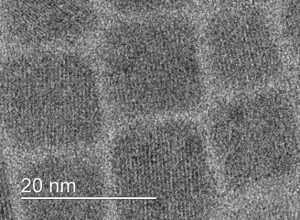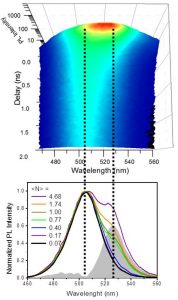
TEM image of cubic shaped Perovskites Quantum Dots
Quantum dots have emerged as a promising new class of materials for applications in technologies such as solar cells and lighting devices. One of the peculiar characteristics of quantum confined semiconductors is that, due to the nanomaterials limited dimensions, the generated excitons are forced to be close together enhancing Coulomb interactions. As a result, processes as Auger recombination, biexciton energy shift and carrier multiplication via impact ionization are strongly affected by the nanomaterial size, composition and shape.

Large biexciton binding energy observed in CsPbI3 Perovskite Quantum Dots
Auger recombination is a nonradiative decay process in which one exciton recombines and the energy is transferred to a third charge (an electron or a hole), which is excited to a higher energy level. Due to its nonradiative nature, this process is less than ideal for lighting applications, e.g., it is one of the main reasons for the low roll off current in quantum dot based LED. On the other hand, high biexciton binding energy can favor low threshold amplified stimulated emission, and carrier multiplication can change the paradigm on how a solar cell operates, breaking the Shockley-Queisser limit.
Single exciton dynamics also play important role in devices efficiency. For example, the rate in which an exciton is dissociated and the charges are collected in a solar cell defines its efficiency. Investigating processes such as charge transfer in different nanomaterials/transport layer interface can elucidate fundamental questions concerning devices architecture.
In this project, our goal is to understand single exciton dynamics and multi-exciton interactions in different classes of semiconductor nanomaterials, understanding some of the factors which has limited their application efficiency and guide the development of novel nanoparticles
